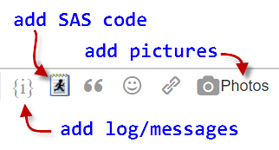- Home
- /
- Programming
- /
- Programming
- /
- count average time interval
- RSS Feed
- Mark Topic as New
- Mark Topic as Read
- Float this Topic for Current User
- Bookmark
- Subscribe
- Mute
- Printer Friendly Page
- Mark as New
- Bookmark
- Subscribe
- Mute
- RSS Feed
- Permalink
- Report Inappropriate Content
this might be tricky in sas,how to count times for each average time interval
below is the case for mssql,and could create a colum interval_time for each customer then sum up.how to achive it in sas?data step or proc sql
CREATE TABLE customer_data (customer_id BIGINT, date DATE, time time, answer VARCHAR(100), missed_call_type VARCHAR(100));
INSERT INTO customer_data
VALUES
(101, '2018/8/3', '12:13:00', 'no', 'employee'),
(102, '2018/8/3', '12:15:00', 'no', 'customer'),
(103, '2018/8/3', '12:20:00', 'no', 'employee'),
(102, '2018/8/3', '15:15:00', 'no', 'customer'),
(101, '2018/8/3', '18:15:00', 'no', 'employee'),
(105, '2018/8/3', '18:18:00', 'no', 'customer'),
(102, '2018/8/3', '19:18:00', 'no', 'employee')
select cd.customer_id, answer, missed_call_type,
CAST(CAST(cd.date as VARCHAR(10))+' ' +CAST(cd.time as VARCHAR(10)) as datetime) as date,
ROW_NUMBER() OVER(PARTITION BY cd.customer_id ORDER BY date desc, time desc) as ranks
INTO #temP
from customer_data cd
order by cd.customer_Id, ranks;
select AVG(DATEDIFF(MINUTE, x1.date, x2.date)) as avg_mins
from #temP x1
INNER JOIN #temP x2 ON x1.customer_id = x2.customer_id
WHERE x2.ranks = (x1.ranks-1)
-------------------------------------------------------------------------update----------------------------------------------------------------------------------------
| cst_id | minutes | time_interval(logic for calculate it) |
| 101 | 362 | 18:15:00-12:13:00=6hours and 2mintes |
| 102 | 423 | [(15:15:00-12:15:00)+(19:18:00-15:15:00)]/2=7hours 3minutes |
this is the procss,if there is anything unclear please tell.thanks!
Accepted Solutions
- Mark as New
- Bookmark
- Subscribe
- Mute
- RSS Feed
- Permalink
- Report Inappropriate Content
Any calculation that relies on data ordering is simpler with a datastep in SAS:
data cd;
set customer_data;
date = dhms(date, 0, 0, time);
format date datetime17.;
drop time;
run;
proc sort data=cd; by customer_id date; run;
data avgTimes;
do nbInt = 1 by 1 until (last.customer_id);
set cd; by customer_id;
if first.customer_id then firstTime = date;
if last.customer_id then lastTime = date;
end;
if nbInt > 1 then do;
totTime = lastTime - firstTime;
avgTime = totTime / (nbInt - 1);
output;
end;
format totTime mmss8. avgTime time9.;
drop nbInt lastTime firstTime date;
run;
- Mark as New
- Bookmark
- Subscribe
- Mute
- RSS Feed
- Permalink
- Report Inappropriate Content
Hello @Geo-,
Your question requires more details before experts can help. Can you revise your question to include more information?
Review this checklist:
- Specify a meaningful subject line for your topic. Avoid generic subjects like "need help," "SAS query," or "urgent."
- When appropriate, provide sample data in text or DATA step format. See this article for one method you can use.
- If you're encountering an error in SAS, include the SAS log or a screenshot of the error condition. Use the Photos button to include the image in your message.
- It also helps to include an example (table or picture) of the result that you're trying to achieve.
To edit your original message, select the "blue gear" icon at the top of the message and select Edit Message. From there you can adjust the title and add more details to the body of the message. Or, simply reply to this message with any additional information you can supply.
SAS experts are eager to help -- help them by providing as much detail as you can.
This prewritten response was triggered for you by fellow SAS Support Communities member @PGStats
.- Mark as New
- Bookmark
- Subscribe
- Mute
- RSS Feed
- Permalink
- Report Inappropriate Content
Any calculation that relies on data ordering is simpler with a datastep in SAS:
data cd;
set customer_data;
date = dhms(date, 0, 0, time);
format date datetime17.;
drop time;
run;
proc sort data=cd; by customer_id date; run;
data avgTimes;
do nbInt = 1 by 1 until (last.customer_id);
set cd; by customer_id;
if first.customer_id then firstTime = date;
if last.customer_id then lastTime = date;
end;
if nbInt > 1 then do;
totTime = lastTime - firstTime;
avgTime = totTime / (nbInt - 1);
output;
end;
format totTime mmss8. avgTime time9.;
drop nbInt lastTime firstTime date;
run;
- Mark as New
- Bookmark
- Subscribe
- Mute
- RSS Feed
- Permalink
- Report Inappropriate Content
- Mark as New
- Bookmark
- Subscribe
- Mute
- RSS Feed
- Permalink
- Report Inappropriate Content
Come to think of it, this problem doesn't rely on ordering. It can also be solved simply with SQL:
data cd;
set customer_data;
date = dhms(date, 0, 0, time);
format date datetime17.;
drop time;
run;
proc sql;
create table avgTimes as
select
customer_id,
range(date) as totTime format=mmss8.,
range(date) / (count(date)-1) as avgTime format=time9.
from cd
group by customer_id
having count(date) > 1;
quit;
April 27 – 30 | Gaylord Texan | Grapevine, Texas
Registration is open
Walk in ready to learn. Walk out ready to deliver. This is the data and AI conference you can't afford to miss.
Register now and save with the early bird rate—just $795!
Learn how use the CAT functions in SAS to join values from multiple variables into a single value.
Find more tutorials on the SAS Users YouTube channel.
SAS Training: Just a Click Away
Ready to level-up your skills? Choose your own adventure.






